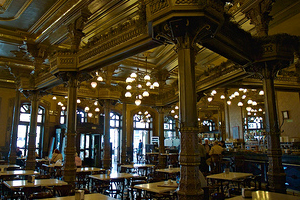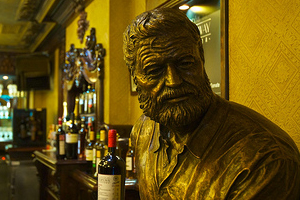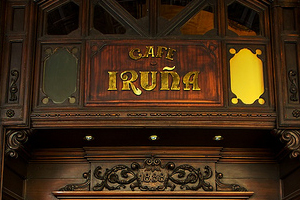So this must have been how Hemingway felt. Walking through the narrow streets of downtown Pamplona, in Northern Spain, I’m slow with wine in the middle of a beautiful September afternoon, thanks to a delectable four-hour, wine-filled lunch (gracias, LaNuez Restaurante!). The physical pace of the city matches my mental state, with the crowd about as thick as my thoughts. It’s all because of a festival called San Fermin Txikito. I—and thousands of others moving at this glacial pace—are on the hunt for those affectionately known as “the big heads” and “the giants.”
Now, if you’re familiar with Hemingway, you already know that something is off here. San Fermin Txikito (pronounced “chi-kito”—Basque for “little one”) is not the same thing as the author’s beloved Fiesta de San Fermin, also known as the Running of the Bulls. The latter takes place in July, when thousands take to the streets (2,000 run on weekdays, 4,000 on weekends, to be exact), sprinting for dear life as six hulking bulls stampede with, around, over and on the runners.
Hemingway made famous the encierro—Spanish for Running of the Bulls—when he fell in love with Pamplona, beginning in 1923. He painted a colorful portrait of the wine- and absinthe-fueled festivities in The Sun Also Rises, his first novel,which was published in 1926.
There are no bulls San Fermin Txikito, nor is there the crowd of nearly 1 million that those bulls now draw each year. This festival, held every September, is small and organic, filling the streets with spontaneous brass band performances, traditional dancers (some of whom wear curious animal furs and bells on their butts) and the occasional impassioned Basque protest. The locals will tell you that this is what San Fermin was like when Hemingway first discovered it—and not at all like the San Fermin it had become following the publication of his book. During his last visit to Pamplona in 1959, the crowd was so raucous Hemingway feared he was responsible for ruining the spirit of the event—and the city.
To read his vivid description in The Sun Also Rises, the festival before me certainly sounds like the one Hemingway knew and loved. “All we could see of the procession through the closely pressed people that crowded all the side streets and curbs were the great giants, cigar-store Indians, thirty feet high, Moors, a King and Queen, whirling, and waltzing solemnly to the riau-riau,” he wrote. He might as well be narrating today’s scene. A towering queen spins through the crowd, followed by a gigantic king. Men dressed as horses bop kids with a ball of foam (seriously—it’s part of the tradition) and oversized head masks with enormous warty faces greet the throngs of people. I now know that when it comes to any kind of surreal sense in Hemingway’s writing about Spain, it wasn’t the absinthe talking. This is the real deal.
There’s no question in my mind why Hemingway loved Pamplona, a laid-back enclave lounging on a plateau, gazing into the Pyrenees Mountains. And there’s no question that the town loved him right back. “We always thank Hemingway because he put us on the map,” say José Luiz López, an architect and tour guide who lives in Pamplona.
Papa Hemingway is given deity status. Statues of the bearded author are everywhere, beginning with the giant, red Plaza de Toros, the third largest bull ring in the world (behind Mexico City and Madrid), where, every July, the bulls (and runners) risk life and limb as they make their way into the ring. Here, a proud Hemingway statue seems to welcome you to all that is bull in Pamplona.
Nearby is the Plaza del Castillo, aka “the living room of Pamplona.” Centuries ago, this was the home to bullfights. Today, and in Hemingway’s time, it’s more likely to be filled with revelers drinking their cider or beer. A large, open square, the Plaza surrounded by the favorite haunts of Hemingway. At El Rincón de Hemingway (Hemingway’s Corner), a small bar with a glowing yellow pallor, a life-sized statue of Hemingway at the bar greets fellow revelers. This bar is located inside a larger café, called Café Iruña, where Hemingway used to write (and his character Jake Barnes spent some time here). Row after row of tables and high ceilings give this spot a bit of a beer-hall feel, but those in the know savor the Rosado while munching on small plates of pintxos, which are tapas with a Basque influence.
Just a few steps away, yet another Hemingway statue (and a bust) greets guests at Gran Hotel La Perla, where Hemingway stayed eight out of his nine visits (he couldn’t afford it his first trip to Pamplona). Up on the fourth floor, the original furniture remains in this preserved room, and the pinkish (or perhaps faded red) upholstery of the wall and couch bears a worn patina that somehow seems to say “historically significant”—particularly in this hotel, where everything else appears brand new. Two glass bookshelves filled with his books—in particular, copy after copy of Fiesta, which the original title of The Sun Also Rises—flank each side of the two single beds. In the corner sits the wooden desk where he used to write, and just to the left of the desk is one of two of his balconies, which give way to dreamy views of the narrow streets below. This is where Hemingway watched the bulls run—and so can guests willing to pony up 2,200 euros a night (almost $3000) with a five-night minimum the first week of San Fermin (it rents for around $700 bucks a night the rest of the year).
Across the Plaza is the casual Bar Txoko, where Hemingway, they say, would drink before and after bullfights and nearby is Café Kutz, which he mentioned in Death in the Afternoon. Statues and nomenclature abound, but it’s also clear that places in Pamplona don’t necessarily have to have a direct tie to Hemingway to invoke his name. I mean, I’d be surprised to hear about Hemingway enjoying a slice of pepperoni at Hemingway Doner Kebab y Pizzeria, which is also located a stone’s throw from the Plaza.
A traveler at heart, Hemingway didn’t just stay in Pamplona proper. I take a day trip, led by Novotour guide Francisco Glaria, down a series of winding roads to Burguete, a tiny town with more narrow streets and stark white buildings. Hemingway would come here before or after the fiesta, to prepare for (or recover from) the mania. Outside of the remarkably plain Hostal Burgete, a sign alerts passersby to Hemingway’s stay there. Inside, there’s proof. In a sparsely furnished dining room sits a polished, wooden piano. Under the lid, it’s marked clear as day: “Hemingway.” The author had carefully carved his name into the wood with a knife.
I continue on to the dense Irati forest—one of the largest forests in Europe. On a curvy, stomach-turning road into the forest, Glaria points to a dilapidated bar to the right. “Hemingway used to drink there.” A few minutes later, the van stops and he leads me up a steep, rocky hill. From the top, you can see the depths of the deep, green forest, and down to a sliver of a river below. It’s the Irati river, Glaria says. “Hemingway used to fish in that river.”
Suddenly, flashing back to the Hemingway Pizzeria, scrutinizing the dilapidated bar, a wave of cynicism flairs. “C’mon!” I demand, asking where the line between “Hemingway connection” and “tourist trap” should be drawn. Glaria’s eyes widen. “It’s true!” he says reverently. “He did! Didn’t you read the book?”
I feel like a heretic.
That night, I go back to my room and find a number of references that very river in The Sun Also Rises. I never should have doubted Glaria—this is Papa Hemingway, after all. For a moment, I wonder if my American cynicism has gone too far. I even consider stopping by the Hemingway pizzeria to find out what his favorite topping was. But I stop myself. Some things are better left to history.



